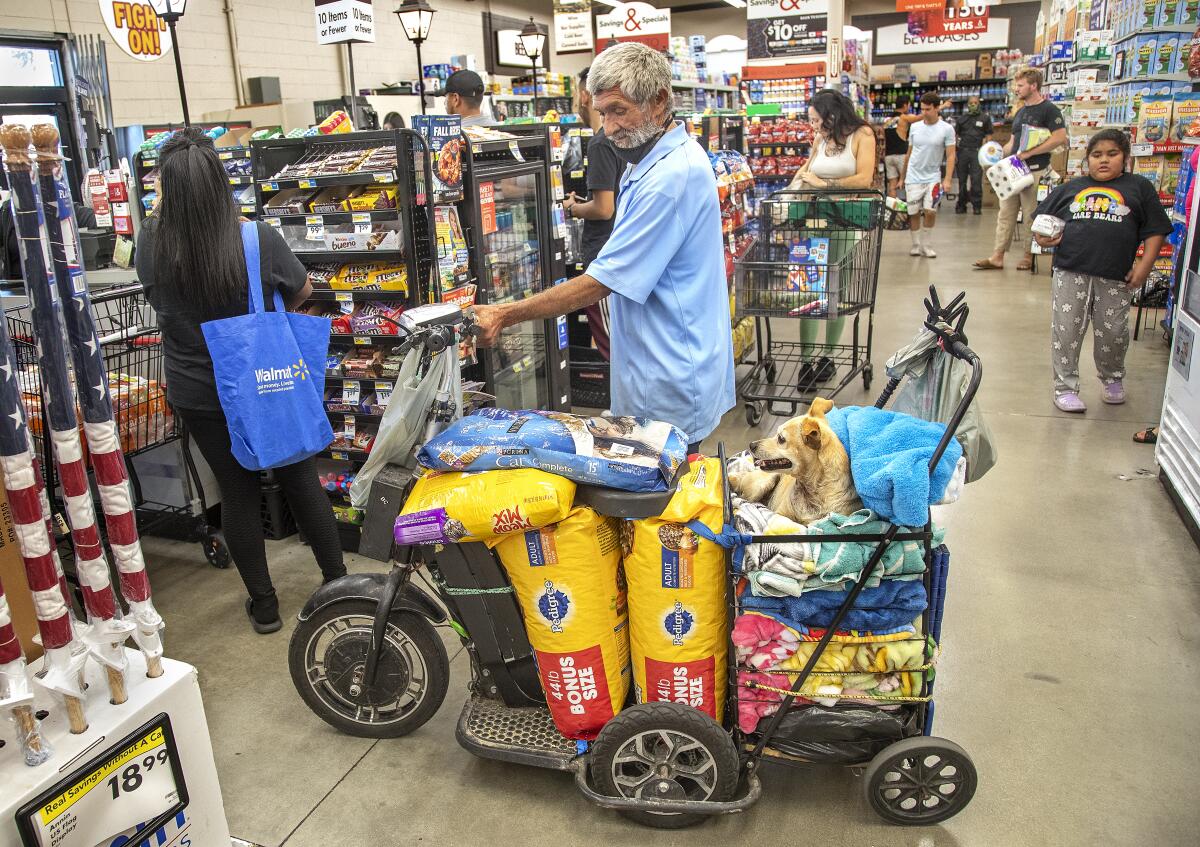Can pets join their owners in stores? Here’s what you should know

Whether perusing the aisles at Costco or grabbing a few things at Target, you most likely have come across a customer walking alongside his or her dog or perhaps pushing the animal around in a shopping cart.
It’s a familiar sight in Southern California. One that might prompt the average shopper to ask: Is that pet allowed to be in the store?
If it’s a service animal, the answer is yes.
Though California law prohibits dogs in facilities that sell packaged food, service dogs are exempt, according to the California Department of Public Health. Under federal law, these same animals are allowed in government offices, businesses and nonprofits that serve the public.
Since 2011, only dogs, of any breed and size, are recognized as service animals, according to the U.S. Department of Justice and Civil Rights.
By appearances alone, it’s tricky to identify whether a dog is a service animal or not because legally it doesn’t have to wear any type of identifying collar or vest. The owner or handler of the animal is also not required have any kind of identification proving it is a service animal, according to the ADA National Network.
If skeptical, ask yourself why you’re questioning the dog’s presence, said Jan Garrett, deputy director of ADA programs for the Pacific ADA Center.
“Are you just being nosy, or do you have a real reason for questioning” why the dog is in the store, she said.
There are ways you might be able to tell if the dog is a legitimate service animal, especially if it’s exhibiting bad behavior, she said.
If you see a dog jumping around a meat counter and pulling food to the ground in a grocery store, this may be an indication that this is not a service animal, she said.
Service animals are always under control and well behaved, she said.
If this is not the case, take your concerns to the store manager, Garrett said.
Here’s what you need to know about identifying service animals and what you can do about it.
So what makes a dog a service animal?
A service animal differs from a pet dog because its trained to help their owner, or handler, who has a disability with physical tasks, Garrett said.
If an owner says their animal provides “comfort” or emotional support but does not identify a specific task that the animal does, that animal is an emotional support animal, not a service animal.
Certification of training isn’t required. Often the handler is training the animal.
For the record:
2:22 p.m. Oct. 4, 2023A previous version of this story said animal handlers can pay for training from Guide Dogs for the Blind. That organization provides free personalized training.
Handlers can pay for professional training from Canine Companions for Independence.
Professionally trained or not, the service animal needs to perform physical tasks for their handler. For example, Garrett said, if the handler has anxiety, the service dog is probably trained to sense their handler is becoming anxious. The dog’s task could be to lead the handler to a bench to sit down or lick their hand and nuzzle them until the handler’s blood pressure and anxiety go down.
The work or task a dog has been trained to provide must be directly related to a person’s disability (physical or mental), according to the U.S. Department of Justice and Civil Rights.
Other examples of tasks include providing guidance for people who are blind, alerting people who are deaf or calming a person with PTSD during an anxiety attack.
Where service animals are allowed?
Under the Americans with Disabilities Act, service animals are allowed in state and local governments offices as well as general businesses and nonprofit organizations that serve the public.
These facilities must allow service animals to accompany people with disabilities in all areas of the facility where the public is allowed to go.
There are limits to where a service animal can be, Garrett said. For example, if the handler is having surgery or in a burn unit (an infection control area), service dogs are not allowed there.
Handlers can take their service animal to the zoo. But there can be parts of the zoo where the animal would be considered a predator or prey to the animals that are contained in their habitats. Zoos, including the Los Angeles Zoo and Botanical Gardens, offer a kennel to board the service animals if the handler wants to visit the restricted areas.
What can you do if a service animal is causing issues in a store?
Service dogs do not need to have any type of identifying tag or gear on them — so you wouldn’t know if the dog is a service animal or not.
If a dog or service animal isn’t behaving, according to the Americans with Disabilities Act, the individual in charge of the office or store is allowed to ask the handler only two questions:
- Is the dog a service animal required because of a disability?
- What tasks has the animal been trained to perform?
If the handler refuses to answer the questions, Garrett said, it is up to the person in charge to decide what action to take. That person can either allow the animal to stay or simply say, “I’m sorry, you have to be able to answer the questions for us to allow the dog into our business or into our agency.”
Under federal law, a handler cannot be asked to remove their service animal from the premises unless the dog is out of control and the handler is unable to restrain the animal.
The Americans with Disabilities Act also states that when there is a legitimate reason to ask that a service animal be removed, the person with the disability must be offered the opportunity to obtain goods or services without the animal’s presence.
If a business is allowing non-service dogs into its store, patrons can call the Los Angeles County Public Health Department’s Customer Support Center at 1-888-700-9995. Or they can file a complaint on the county’s website.
Start your day right
Sign up for Essential California for news, features and recommendations from the L.A. Times and beyond in your inbox six days a week.
You may occasionally receive promotional content from the Los Angeles Times.




